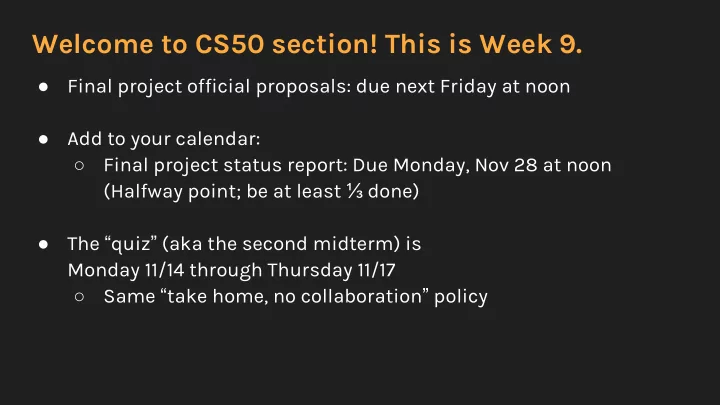

Welcome to CS50 section! This is Week 9. ● Final project official proposals: due next Friday at noon ● Add to your calendar: Final project status report: Due Monday, Nov 28 at noon ○ (Halfway point; be at least ⅓ done) ● The “ quiz ” (aka the second midterm) is Monday 11/14 through Thursday 11/17 ○ Same “ take home, no collaboration ” policy
Welcome to Python Python lets us write smarter programs, faster. Course timeline: Raw C code Distribution C code Raw Python code Framework Python code (Flask) HTML/CSS JavaScript JavaScript frameworks (jQuery)
Before starting pset 7 Conceptual basics of Python ● ● Flask ○ Decorators and routes ○ MVC in the context of Flask ● SQL queries
Final project roundtable
Conceptual basics Review Week 8 slides (http://brandon.wang/cs50) ● You must know the basics of Python to proceed! ○ Syntax, structures, loops, data types Most people will make a final project in Python/Flask. ● ● Less important to carry over skills from C, More important to know how Python implements things
Brief review Data types in Python ● ○ Lists ○ Tuples ○ Dictionaries ● Function definitions ○ Optional arguments
Functions In Python, functions are first-class objects. ● Data type like everything else ● Can be overridden ● Can be passed around (although try not to)
Functions Why does this matter? ● Python’s flexible definition of a data type is a design choice ● Can’t call a function the same name as a variable ● Same scoping of a variable applies to a function
Decorators Decorators in Python are functions that modify the behavior of other functions, typically applying some extra functionality hereto.
Decorators Decorators in Python are functions that modify the behavior of other functions, typically applying some extra functionality hereto. ● Within the context of CS50/pset 7, decorators set the “ route ” , require users to be logged in, etc. ● Within Python, decorators are a simple way of adding wrapper functionality to a program.
Decorators → Contrived example def override(func): def incr(): return func() + 1 return incr @override def one(): return 1 # What happens? print(one())
Routes Think of routes as pathways to functions ● ● We’re mapping URLs to functions ○ It’s a many-to-one relationship
Routes Think of routes as pathways to functions ● ● We’re mapping URLs to functions ○ It’s a many-to-one relationship In Flask, routes are defined using a decorator: ● @app.route()
Routes A really simple Flask app might look like: from flask import Flask app = Flask(__name__) @app.route("/") def index(): return "You are at the index!"
MVC In pset 7, we use a loose form of MVC. ● Models and controllers go in application.py. ● Set up your views (eg. visual layouts) through Jinja templates.
MVC What are the distinctions to know? ● Routes don’t map to URLs (many URLs to one route) ● Routes do map to functions (many routes to one function) Views/templates don’t map to routes ● ● Views/templates don’t map to anything ● Views/templates are just things that your functions can call
Jinja Flask views are primarily structured through Jinja. Jinja is a Python-inspired language for making templates, ways of showing things (rendering) in the browser.
Jinja Flask views are primarily structured through Jinja. Jinja is a Python-inspired language for making templates, ways of showing things (rendering) in the browser. ● Cool things with Jinja Jinja templates cascade (i.e. extend) ○ ○ Jinja templates interweave HTML and Python Not too much explanation here-- read problem spec.
SQL
Databases and SQL
Databases and SQL Key elements of database design ● ○ Databases have multiple tables ○ Columns have data types ○ Tables have primary keys Tables have commonalities ○
SQL SQL queries are statements that you send to a database server. The server responds according to your statement. In Flask, use db.execute() to run SQL queries. SQL = “ Structured query language ”
SQL Do programmers write SQL queries anymore? (Not really.) But the underlying mechanism generally continues to be SQL.
SQL SQL obeys the CRUD process: ● C: Create ● R: Read ● U: Update D: Delete ●
SQL SQL obeys the CRUD process: ● C: Create ○ INSERT INTO ● R: Read SELECT ○ ● U: Update ○ UPDATE ● D: Delete DELETE ○
SQL → Base vocabulary Insertions: “ INSERT INTO <table> (<columns>) VALUES (<values>) ” Selections: “ SELECT <columns> FROM <table> ” Updates: “ UPDATE <table> SET <column1> = <value1>, <column2> = <value2> ” Deletions: “ DELETE FROM <table> ”
SQL → More vocabulary All of these are usually paired with conditions, etc.: ● WHERE is nearly always included ○ Limits the scope of the query JOIN lets operations on multiple tables occur ●
SQL example
That’s all for today!
Recommend
More recommend